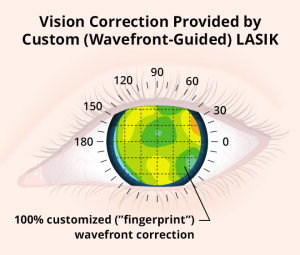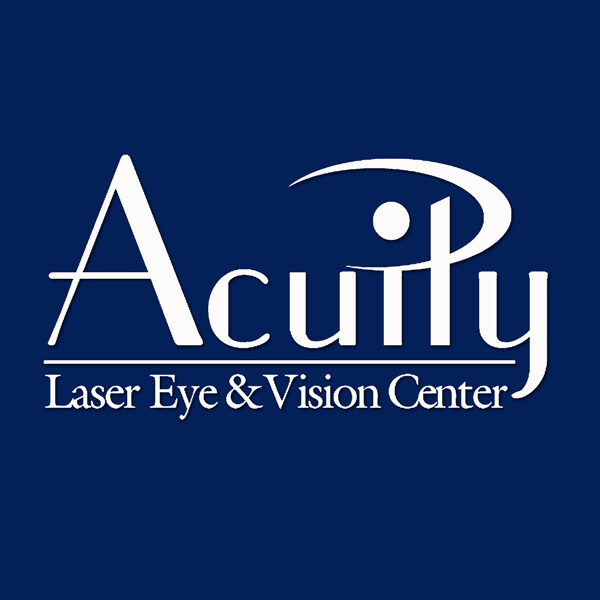by Keith Croes; reviewed by Brian S. Boxer Wachler, MD, and Vance Thompson, MD

Custom LASIK surgery, also known as wavefront LASIK or wavefront-guided LASIK, uses 3-dimensional measurements of how your eye processes images to guide the laser in re-shaping the front part of the eye (cornea). With a wavefront measurement system, some extremely precise, individualized vision correction outcomes may be achieved that would be impossible with traditional LASIK surgery, contact lenses or eyeglasses.
You should be qualified under FDA guidelines before custom wavefront LASIK is considered for your eye condition. Depending on the custom laser system used and other factors such as appropriate thickness of your cornea, you might be considered a candidate if you have mild to moderately high degrees of common vision defects such as myopia, hyperopia and astigmatism.
With custom LASIK, your eye’s ability to focus light rays is measured, and a 3-D map used in wavefront technology is created that demonstrates irregularities in the way your eye processes images. Information contained in the map guides the laser in customizing the treatment to reshape your eye’s corneal surface so that these irregularities can be corrected.
Standard prescriptions for glasses, contacts or traditional LASIK procedures can correct ordinary vision defects such as myopia, hyperopia, and astigmatism. But other irregularities associated with the eye’s optical system could not be addressed until the advent of wavefront and related technology used in custom LASIK.
Potential Benefits of Wavefront-Guided Custom LASIK
Wavefront technology is groundbreaking because it has the potential to improve not only how much you can see, visual acuity measured by the standard 20/20 eye chart, but also how well you can see, in terms of contrast sensitivity and fine detail.
This translates into a reduced risk of post-LASIK complications, such as glare, halos and difficulty with night vision.
How much you see depends on vision defects known as lower-order aberrations associated with common refractive errors including myopia, hyperopia and astigmatism, which traditional LASIK can treat.
How well you see can depend on presence of the type and numbers of visual distortions known as higher-order aberrations, which are optical defects other than common refractive errors.
 Higher-order aberrations can create problems such as decreased contrast sensitivity or night vision, glare, shadows and halos. However, higher-order aberrations do not always affect vision. Unlike traditional LASIK, custom LASIK treats both lower- and higher-order aberrations.
Higher-order aberrations can create problems such as decreased contrast sensitivity or night vision, glare, shadows and halos. However, higher-order aberrations do not always affect vision. Unlike traditional LASIK, custom LASIK treats both lower- and higher-order aberrations.
Custom LASIK’s advantage lies in the area of quality of vision:
• Greater chance of achieving 20/20 vision
• Greater chance of achieving better than 20/20 vision
• Reduced chance of losing best-corrected vision
• Reduced chance of losing visual quality or contrast sensitivity
• Reduced chance of night-vision disturbances and glare
Potential also exists for custom LASIK to treat people who have lost best-corrected vision from any past refractive surgery: LASIK, PRK, RK, etc.
“Sometimes patients complain about vision quality problems, such as not being able to see in dim or low light. This is referred to as poor contrast sensitivity,” said Roger Steinert, MD, vice chair of clinical ophthalmology and professor at University of California Irvine.
“Prior to the advent of wavefront measurements, there wasn’t anything we could do to measure or treat higher-order aberrations,” Steinert said. “With this technology breakthrough, we can now measure these disorders, show the patient what’s going on in their eye, link that information to the laser, and actually correct higher-order aberrations that diminish contrast sensitivity. Wavefront technology enables the surgeon to improve overall vision quality better than in the past.”
Not all refractive surgeons agree that wavefront-guided LASIK can treat higher order aberrations. In fact, studies show that both wavefront LASIK and conventional LASIK can sometimes cause these aberrations because of artificial changes made to the natural shape of the eye’s surface.
However, wavefront-guided LASIK may be less likely to induce higher-order aberrations than conventional LASIK, according to discussion in the April 2005 issue of Ophthalmology Times.
Most refractive surgeons now use wavefront-guided LASIK in their practices, according to recent surveys such as those conducted by the American Society of Cataract and Refractive Surgery (ASCRS).
FDA-APPROVED CUSTOM LASIK SYSTEMS
Laser System and Manufacturer
FDA-Approved Indications
Features
LADARVision 4000 with CustomCornea (Alcon)
Myopia: up to -8 D with or without myopic astigmatism up to -4 D
Hyperopia and hyperopic astigmatism: up to +5 D (near vision problems) and astigmatism causing distance vision problems up to -3 D
Eye tracking, integrated wavefront, small spot system for precise laser application
Technolas 217z Zyoptix System (Bausch + Lomb)
Myopia: up to -7 D with or without up to -3 D myopic astigmatism and total refractive error equal to or less than 7.5 D
Integrated wavefront and “flying spot,” meaning fast, uniform application of laser beam with each pulse for smooth corneal surface
Star S4 ActiveTrak with CustomVue (Visx, now owned by Abbott Medical Optics or AMO)
Myopia: up to -6 D, with or without up to -3 D myopic astigmatism
Hyperopia: up to +3 D with or without up to +2 D for hyperopic astigmatism
Eye tracking, integrated wavefront, no pupil dilation required, which speeds up procedure, unique wavefront analysis system known as Fourier for increased resolution
Star S4 IR with CustomVue (Visx, now owned by Abbott Medical Optics or AMO)
Myopia: up to -6 D with or without up to -3 D of myopic astigmatism
Hyperopia: up to +3 D with or without up to +2 D of hyperopic astigmatism
Mixed astigmatism: up to 5 D
In addition to features of S4 ActiveTrak, includes Iris Registration (IR), which adjusts the laser treatment to take into account any rotation of the eye that may occur when the patient is in the prone position (lying down) during surgery
Allegretto Wave with Allegro Analyzer (WaveLight, now owned by Alcon)
Myopia: up to -7 D with or without up to 3 D of astigmatism
Scanning spot system, eye tracking, integrated wavefront, algorithm (mathematical measurement) based on population studies that helps minimize possibility that a vision error known as spherical aberration might be induced during vision correction
Note: D refers to diopters.
(Please note that the Nidek EC-5000 series excimer laser system used at Acuity Laser Eye & Vision Center locations was not approved for custom AT  THE TIME THIS ARTICLE WAS WRITTEN, but currently is FDA approved for custom laser vision correction, hence its absence from the list above.)
THE TIME THIS ARTICLE WAS WRITTEN, but currently is FDA approved for custom laser vision correction, hence its absence from the list above.)
How Custom LASIK Works
The process for determining a custom LASIK treatment begins with the use of a wavefront device to transmit a safe ray of light into your eye. The light is then reflected back off the retina, out through the pupil, and into the device, where the reflected wave of light is received and arranged into a unique pattern that captures your lower- and higher-order aberrations.
All of these visual irregularities are then displayed as a 3-D map, referred to as a wavefront map. This information is then electronically transferred to the laser (in wavefront-guided systems), and computer-matched to the eye’s position, enabling the surgeon to customize the LASIK procedure laser treatment (or “ablation”) to your unique visual requirements.
Getting Wavefront-Guided Custom LASIK
Custom LASIK costs usually are significantly more than traditional LASIK, partly because surgeons pay a higher royalty fee to the device manufacturer for each procedure.
Research is continuing into expanding the degree of vision errors (such as high myopia) that can be corrected with custom LASIK. Investigations also are underway for use of custom LASIK to create multifocal corrections in a procedure known as PresbyLASIK, which would enable older eyes that have developed presbyopia to see at near, middle and distant ranges at the same time.
Investigators have reported early promising results of wavefront LASIK, combined with automated topographical measurements of the eye’s surface during a procedure, to help reduce surgically induced aberrations and astigmatism. Early studies also indicate that night vision might be further improved with this approach.*
Like conventional LASIK, custom LASIK won’t cure all vision-related problems, so it’s important to discuss its applications with your eye doctor or surgeon to determine if you are a good candidate.
http://www.allaboutvision.com/visionsurgery/custom_lasik.htm



Comments are closed